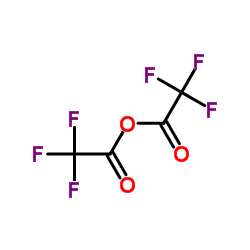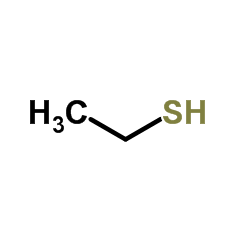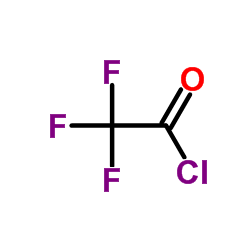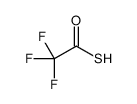383-64-2
| 中文名 | 乙基三氟巯基乙酯 |
|---|---|
| 英文名 | s-ethyl trifluorothioacetate |
| 中文别名 |
三氟硫代乙酸S-乙酯
三氟硫代乙酸 S-乙酯 三氟乙酸乙硫醇酯 S-乙基三氟硫代乙酸酯 |
| 英文别名 |
Trifluorothioacetic Acid S-Ethyl Ester
S-ethyl 2,2,2-trifluoroethanethioate EINECS 206-852-1 MFCD00000421 S-Ethyl Trifluorothioacetate [Trifluoroacetylating Agent |
| 密度 | 1.234 g/mL at 25 °C(lit.) |
|---|---|
| 沸点 | 90.5 °C(lit.) |
| 分子式 | C4H5F3OS |
| 分子量 | 158.14200 |
| 闪点 | 39 °F |
| 精确质量 | 158.00100 |
| PSA | 42.37000 |
| LogP | 1.82840 |
| 外观性状 | 液体;Colorless to Light yellow clear liquid |
| 折射率 | n20/D 1.376(lit.) |
| 储存条件 | 本品应密封于阴凉处保存。 |
| 稳定性 | 易燃。对呼吸系统有刺激性。 |
| 分子结构 | 1、 摩尔折射率:29.06 2、 摩尔体积(m3/mol):122.0 3、 等张比容(90.2K):270.6 4、 表面张力(dyne/cm):24.1 5、 极化率(10 -24cm 3):11.52 |
| 计算化学 | 1.疏水参数计算参考值(XlogP):2.1 2.氢键供体数量:0 3.氢键受体数量:5 4.可旋转化学键数量:2 5.互变异构体数量:无 6.拓扑分子极性表面积42.4 7.重原子数量:9 8.表面电荷:0 9.复杂度:109 10.同位素原子数量:0 11.确定原子立构中心数量:0 12.不确定原子立构中心数量:0 13.确定化学键立构中心数量:0 14.不确定化学键立构中心数量:0 15.共价键单元数量:1 |
| 更多 | 一、物性数据 性状:液体 密度(g/mL,25/4℃):1.234 相对蒸汽密度(g/mL,空气=1):不可用 熔点(ºC):不可用 沸点(ºC,常压):90.4 沸点(ºC,5.2kPa):不可用 折射率:1.376 闪点(ºC):不可用 比旋光度(º):不可用 自燃点或引燃温度(ºC):不可用 蒸气压(kPa,25ºC):不可用 饱和蒸气压(kPa,60ºC):不可用 燃烧热(KJ/mol):不可用 临界温度(ºC):不可用 临界压力(KPa):不可用 油水(辛醇/水)分配系数的对数值:不可用 爆炸上限(%,V/V):不可用 爆炸下限(%,V/V):不可用 溶解性:不可用 |
Synonym: Section 2 - COMPOSITION, INFORMATION ON INGREDIENTS
Risk Phrases: 11 36/37/38 Section 3 - HAZARDS IDENTIFICATION EMERGENCY OVERVIEW
Highly flammable. Irritating to eyes, respiratory system and skin.The toxicological properties of this material have not been fully investigated. Potential Health Effects Eye: May cause eye irritation. The toxicological properties of this material have not been fully investigated. Skin: May cause skin irritation. The toxicological properties of this material have not been fully investigated. Ingestion: May cause gastrointestinal irritation with nausea, vomiting and diarrhea. The toxicological properties of this substance have not been fully investigated. Inhalation: May cause respiratory tract irritation. The toxicological properties of this substance have not been fully investigated. Vapors may cause dizziness or suffocation. Chronic: No information found. Section 4 - FIRST AID MEASURES Eyes: Flush eyes with plenty of water for at least 15 minutes, occasionally lifting the upper and lower eyelids. Get medical aid. Skin: Get medical aid. Flush skin with plenty of water for at least 15 minutes while removing contaminated clothing and shoes. Wash clothing before reuse. Ingestion: If victim is conscious and alert, give 2-4 cupfuls of milk or water. Never give anything by mouth to an unconscious person. Get medical aid immediately. Inhalation: Remove from exposure and move to fresh air immediately. If not breathing, give artificial respiration. If breathing is difficult, give oxygen. Get medical aid. Notes to Physician: Section 5 - FIRE FIGHTING MEASURES General Information: As in any fire, wear a self-contained breathing apparatus in pressure-demand, MSHA/NIOSH (approved or equivalent), and full protective gear. Vapors may form an explosive mixture with air. Vapors can travel to a source of ignition and flash back. During a fire, irritating and highly toxic gases may be generated by thermal decomposition or combustion. Use water spray to keep fire-exposed containers cool. Extremely flammable liquid and vapor. Containers may explode in the heat of a fire. Will be easily ignited by heat, sparks or flame. Extinguishing Media: For small fires, use dry chemical, carbon dioxide, water spray or alcohol-resistant foam. For large fires, use water spray, fog, or alcohol-resistant foam. Use water spray to cool fire-exposed containers. Water may be ineffective. Do NOT use straight streams of water. Section 6 - ACCIDENTAL RELEASE MEASURES General Information: Use proper personal protective equipment as indicated in Section 8. Spills/Leaks: Absorb spill with inert material (e.g. vermiculite, sand or earth), then place in suitable container. Clean up spills immediately, observing precautions in the Protective Equipment section. Remove all sources of ignition. Use a spark-proof tool. Provide ventilation. A vapor suppressing foam may be used to reduce vapors. Section 7 - HANDLING and STORAGE Handling: Wash thoroughly after handling. Use only in a well-ventilated area. Ground and bond containers when transferring material. Avoid contact with eyes, skin, and clothing. Empty containers retain product residue, (liquid and/or vapor), and can be dangerous. Keep container tightly closed. Keep away from heat, sparks and flame. Avoid ingestion and inhalation. Do not pressurize, cut, weld, braze, solder, drill, grind, or expose empty containers to heat, sparks or open flames. Storage: Keep away from heat, sparks, and flame. Keep away from sources of ignition. Store in a tightly closed container. Store in a cool, dry, well-ventilated area away from incompatible substances. Flammables-area. Section 8 - EXPOSURE CONTROLS, PERSONAL PROTECTION Engineering Controls: Use adequate general or local exhaust ventilation to keep airborne concentrations below the permissible exposure limits. Exposure Limits CAS# 383-64-2: United States OSHA: 2.5 mg/m3 TWA (as F) (listed under Fluorides Personal Protective Equipment Eyes: Wear appropriate protective eyeglasses or chemical safety goggles as described by OSHA's eye and face protection regulations in 29 CFR 1910.133 or European Standard EN166. Skin: Wear appropriate protective gloves to prevent skin exposure. Clothing: Wear appropriate protective clothing to prevent skin exposure. Respirators: Follow the OSHA respirator regulations found in 29 CFR 1910.134 or European Standard EN 149. Use a NIOSH/MSHA or European Standard EN 149 approved respirator if exposure limits are exceeded or if irritation or other symptoms are experienced. Section 9 - PHYSICAL AND CHEMICAL PROPERTIES Physical State: Liquid Color: colorless Odor: Not available. pH: Not available. Vapor Pressure: Not available. Viscosity: Not available. Boiling Point: 90.4 deg C @ 760.00mm Hg Freezing/Melting Point: Not available. Autoignition Temperature: Not available. Flash Point: 3 deg C ( 37.40 deg F) Explosion Limits, lower: Not available. Explosion Limits, upper: Not available. Decomposition Temperature: Solubility in water: Specific Gravity/Density: 1.2340g/cm3 Molecular Formula: C4H5F3OS Molecular Weight: 158.14 Section 10 - STABILITY AND REACTIVITY Chemical Stability: Stable under normal temperatures and pressures. Conditions to Avoid: Incompatible materials, ignition sources, dust generation, excess heat, strong oxidants. Incompatibilities with Other Materials: Strong bases, strong acids, strong reducing agents, strong oxidizing agents. Hazardous Decomposition Products: Carbon monoxide, irritating and toxic fumes and gases, carbon dioxide, hydrogen fluoride gas, hydrogen sulfide, sulfur oxides (SOx), including sulfur oxide and sulfur dioxide. Hazardous Polymerization: Has not been reported Section 11 - TOXICOLOGICAL INFORMATION RTECS#: CAS# 383-64-2 unlisted. LD50/LC50: Not available. Carcinogenicity: S-Ethyl Trifluorothioacetate - Not listed by ACGIH, IARC, or NTP. Section 12 - ECOLOGICAL INFORMATION Section 13 - DISPOSAL CONSIDERATIONS Dispose of in a manner consistent with federal, state, and local regulations. Section 14 - TRANSPORT INFORMATION IATA Shipping Name: FLAMMABLE LIQUID, N.O.S.* Hazard Class: 3 UN Number: 1993 Packing Group: II IMO Shipping Name: FLAMMABLE LIQUID, N.O.S. Hazard Class: 3.2 UN Number: 1993 Packing Group: II RID/ADR Shipping Name: FLAMMABLE LIQUID, N.O.S. Hazard Class: 3 UN Number: 1993 Packing group: II Section 15 - REGULATORY INFORMATION European/International Regulations European Labeling in Accordance with EC Directives Hazard Symbols: XI F Risk Phrases: R 11 Highly flammable. R 36/37/38 Irritating to eyes, respiratory system and skin. Safety Phrases: S 9 Keep container in a well-ventilated place. S 16 Keep away from sources of ignition - No smoking. S 28A After contact with skin, wash immediately with plenty of water. S 33 Take precautionary measures against static discharges. S 37 Wear suitable gloves. S 45 In case of accident or if you feel unwell, seek medical advice immediately (show the label where possible). WGK (Water Danger/Protection) CAS# 383-64-2: No information available. Canada CAS# 383-64-2 is listed on Canada's DSL List. CAS# 383-64-2 is not listed on Canada's Ingredient Disclosure List. US FEDERAL TSCA CAS# 383-64-2 is listed on the TSCA inventory. SECTION 16 - ADDITIONAL INFORMATION N/A |
|
毒理学数据: 二、毒理学数据: 急性毒性:不可用。 生态学数据: 三、生态学数据: 1、其它有害作用:该物质对环境可能有危害,对水体应给予特别注意。
|
| 符号 |


GHS02, GHS07 |
|---|---|
| 信号词 | Danger |
| 危害声明 | H225-H315-H319-H335 |
| 警示性声明 | P210-P261-P305 + P351 + P338 |
| 个人防护装备 | Eyeshields;Faceshields;full-face respirator (US);Gloves;multi-purpose combination respirator cartridge (US);type ABEK (EN14387) respirator filter |
| 危害码 (欧洲) | F: Flammable;Xi: Irritant; |
| 风险声明 (欧洲) | R11;R36/37/38 |
| 安全声明 (欧洲) | S16-S26-S36 |
| 危险品运输编码 | UN 3272 3/PG 2 |
| WGK德国 | 3 |
| 包装等级 | II |
| 危险类别 | 3.1 |
| 海关编码 | 2930909090 |
|
~% 
383-64-2 |
| 文献:Bock,E. et al. Canadian Journal of Chemistry, 1974 , vol. 52, p. 3113 - 3118 Full Text Show Details Hauptschein et al. Journal of the American Chemical Society, 1952 , vol. 74, p. 4005,4007 |
|
~% 
383-64-2 |
| 文献:Hauptschein et al. Journal of the American Chemical Society, 1952 , vol. 74, p. 4005,4007 |
|
~48% 
383-64-2 |
| 文献:Weeks, P.; Gard, G. L. Journal of Fluorine Chemistry, 1971 , vol. 1, p. 295 - 307 |
| 海关编码 | 2930909090 |
|---|---|
| 中文概述 | 2930909090. 其他有机硫化合物. 增值税率:17.0%. 退税率:13.0%. 监管条件:无. 最惠国关税:6.5%. 普通关税:30.0% |
| 申报要素 | 品名, 成分含量, 用途 |
| Summary | 2930909090. other organo-sulphur compounds. VAT:17.0%. Tax rebate rate:13.0%. . MFN tariff:6.5%. General tariff:30.0% |






